Last updated on
Discover the secrets to maintaining your pristine white couch with our expert cleaning tips and tricks that’ll keep it looking fresh and spotless for years to come.
A white couch is a beautiful addition to any living room, but it can be a nightmare to keep clean. From spills and stains to pet hair and dirt, it seems like everything is out to ruin the pristine look of your couch.
But fear not! With the right techniques and tools, you can keep your white couch looking as good as new for years to come. In this article, we’ll share some tips and tricks on how to keep a white couch clean, so you can enjoy its elegance without worrying about the mess.
So sit back (on your freshly cleaned white couch) and let’s get started!
Table of Contents
Choose the Right Fabric

The first step in keeping your white couch clean is to choose the right fabric. Not all fabrics are created equal, and some are more stain-resistant than others.
When shopping for a white couch, look for fabrics that are easy to clean and maintain. Leather or microfiber sofas can be great options as they repel stains and spills better than other materials.
If you prefer a fabric sofa, consider choosing one with removable covers that can be washed or dry cleaned easily. Avoid textured fabrics like chenille or velvet as they tend to trap dirt and dust particles making them harder to keep clean.
It’s also important to consider the durability of the fabric when selecting your white couch material; this will ensure it lasts longer without showing signs of wear-and-tear quickly.
Invest in a Good Quality Couch

A high-quality couch will not only look better but also be easier to maintain over time. Look for durable fabrics that are easy to clean and resist stains, such as leather or microfiber.
While it may be tempting to go for the cheapest option available, keep in mind that you get what you pay for. Cheaper materials may not hold up well over time and can stain easily.
A good quality white couch will also have sturdy construction with strong seams and supportive cushions that won’t sag or lose their shape quickly. This means less maintenance overall since you won’t have to constantly fluff your cushions or worry about them losing their support.
Use Stain Protection
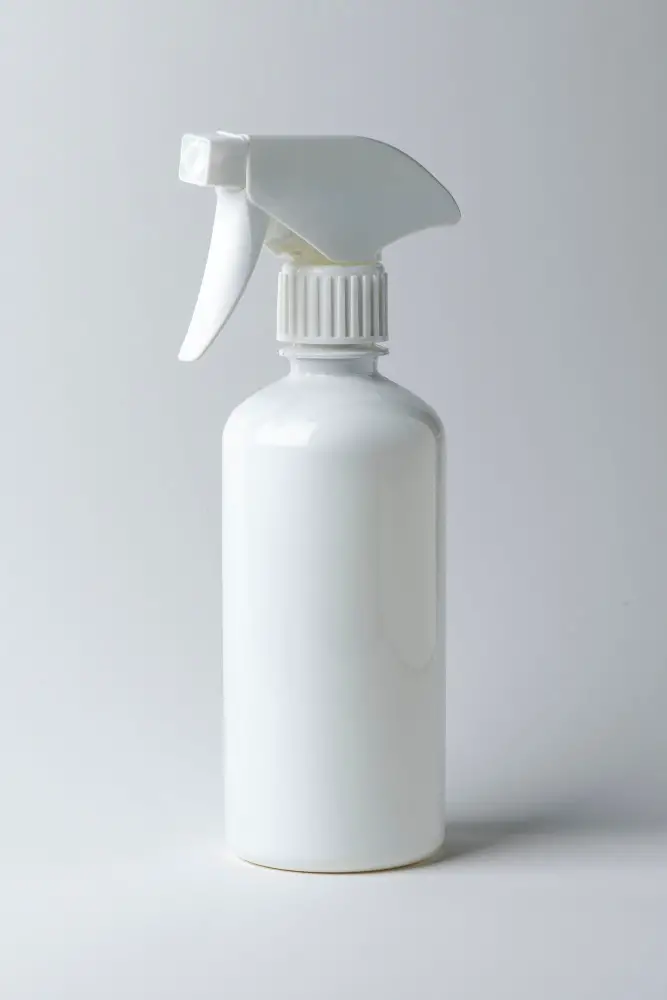
This can be in the form of a spray-on product or a professionally applied treatment. Stain protection works by creating an invisible barrier on the fabric that repels liquids and prevents them from soaking into the fibers.
When choosing a stain protector, make sure it’s safe for use on your specific type of couch fabric. Follow all instructions carefully and apply it evenly across all surfaces, including cushions and armrests.
Keep in mind that no stain protector is foolproof, so spills should still be dealt with immediately to prevent any potential damage or staining.
Use Slipcovers
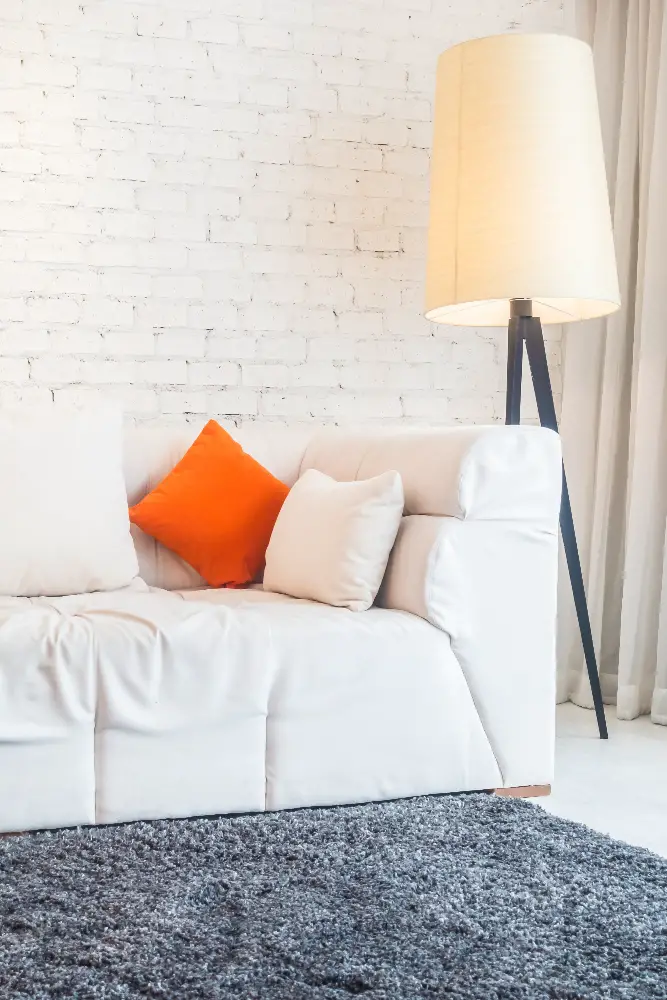
They come in various colors and fabrics that can complement your decor while keeping the couch clean. Slipcovers are also easy to remove and wash, making them an ideal solution for families with kids or pets.
When choosing slipcovers for your white couch, make sure they fit snugly without bunching up or slipping off. Loose-fitting covers can be uncomfortable to sit on as they tend to wrinkle easily.
Another advantage of using slipcovers is that you can change the look of your living room without having to buy a new sofa altogether. You could switch between different colors or patterns depending on the season or occasion.
However, keep in mind that not all slipcovers are created equal; some may shrink after washing while others may fade over time due to exposure from sunlight. So it’s essential always read care instructions before purchasing any coverings for furniture pieces like sofas.
No Shoes Policy
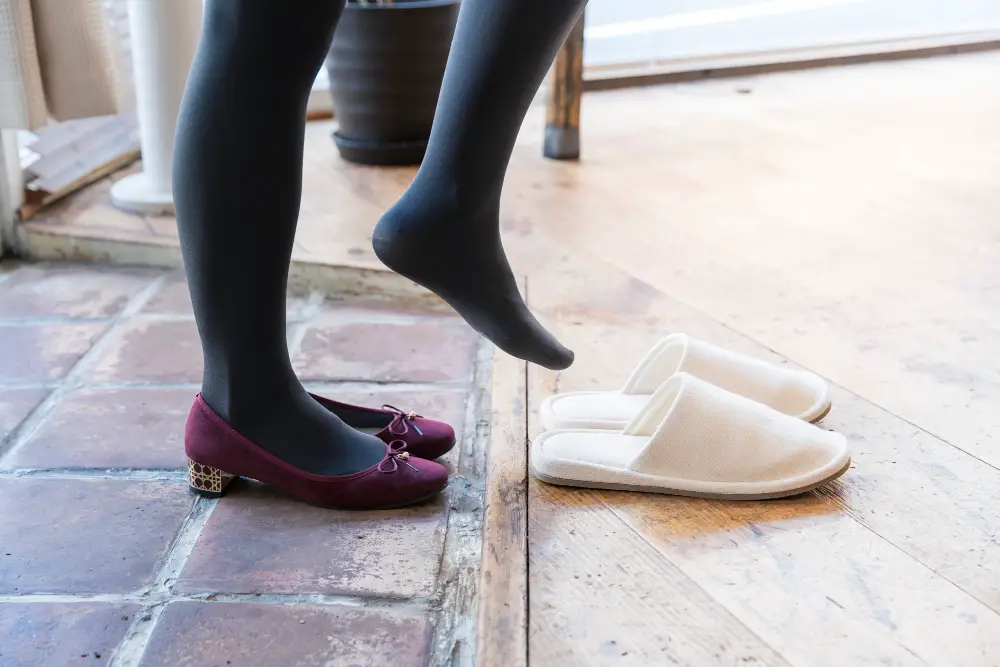
Shoes can track dirt, mud, and other debris onto your couch, leaving unsightly stains that are difficult to remove. By asking guests and family members to remove their shoes before entering the living room or sitting on the couch, you can significantly reduce the amount of dirt and grime that accumulates on its surface.
To make it easier for everyone in your household to follow this rule, consider placing a shoe rack or basket near the entrance of your home where people can store their footwear when they come inside. You could also provide slippers or socks for guests who may feel uncomfortable walking around barefoot.
Set House Rules
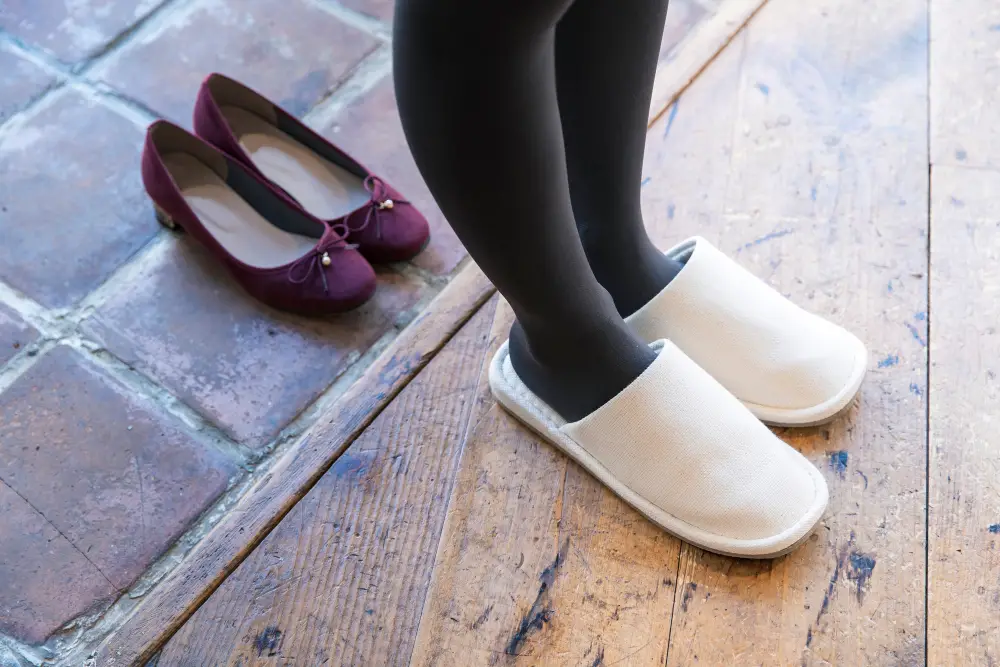
Establishing guidelines for how people should behave around the couch can go a long way in preventing spills and stains. For example, you could ask guests to remove their shoes before sitting on the couch or ban food and drinks from being consumed while seated on it.
It’s important to communicate these rules clearly with everyone who uses your living room, so they know what’s expected of them. You might even want to put up a sign near the sofa as a reminder.
By setting house rules, you’ll be able to enjoy your white couch without worrying about accidental spills or stains caused by careless behavior.
Ban Food and Drink

While this may seem like a no-brainer, accidents can happen, especially if you have kids or pets in the house. Even something as innocent as a glass of water can leave unsightly stains on your couch if spilled.
To avoid any mishaps, make sure everyone in your household knows that food and drinks are not allowed on the white couch. If you’re hosting guests who want to eat or drink while watching TV, provide them with trays or tables where they can place their snacks and beverages.
Keep Pets Off

If you have pets, it’s important to train them not to jump on the couch or use it as their personal scratching post. This will help prevent scratches, tears and stains caused by pet hair or accidents.
One way to keep pets off the couch is by providing them with their own designated space in the room where they can relax comfortably. You could place a cozy bed for your furry friend near the couch so that they feel included in family time without being tempted to climb onto your white sofa.
Another option is using deterrents such as double-sided tape or aluminum foil on areas where you don’t want your pet climbing up. These materials create an unpleasant sensation when touched which discourages animals from jumping onto surfaces like sofas.
Rotate Cushions
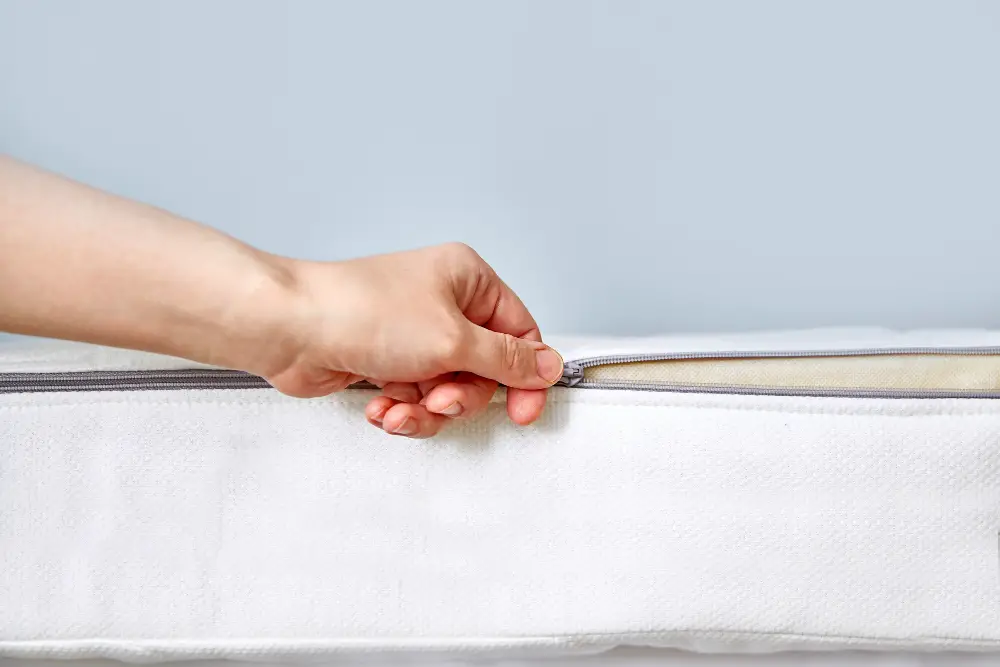
Over time, the cushions can become compressed and misshapen from regular use, which can make your couch look worn out and tired. By flipping and rotating them every few weeks, you’ll distribute the wear more evenly across all of the cushions.
To rotate your cushions properly, remove them from their covers (if possible) and flip them over so that they’re facing in a different direction than before. If there are any particularly flat or lumpy areas on a cushion, try fluffing it up with your hands or hitting it gently against a hard surface to redistribute its filling.
Avoid Direct Sunlight

To avoid this, position your couch away from direct sunlight or use curtains or blinds to block the sun’s rays during peak hours. If you have no choice but to place your white couch in a sunny spot, consider investing in UV-protective window film that will help reduce the amount of light that enters the room.
It’s also important to note that while natural light is great for brightening up a space and creating an inviting atmosphere, it can still cause damage if not managed properly. So take care when positioning any furniture near windows and make sure you’re taking steps like using protective films or shades as needed.
Follow Manufacturer Instructions

Different fabrics and materials require different care, so make sure you read the label or manual that came with your couch before attempting any cleaning. Some fabrics may be sensitive to certain chemicals or methods of cleaning, which could cause discoloration or damage.
If you’re unsure about how to clean a particular stain on your white couch, don’t hesitate to contact the manufacturer for advice. They may have specific recommendations for dealing with tough stains that are unique to their product.
Vacuum Regularly

Dust, dirt, and pet hair can accumulate on your couch over time and cause discoloration or even damage to the fabric. By vacuuming at least once a week (or more if you have pets), you’ll remove any loose debris before it has a chance to settle in.
When vacuuming your white couch, use an upholstery attachment with soft bristles that won’t scratch or damage the fabric. Start by removing any cushions and vacuum them separately on both sides.
Then move onto the main body of the couch, making sure to get into all crevices and corners where dust tends to collect.
If there are any stains or spills on your white couch before starting with this process make sure they are completely dry first as wet cleaning may worsen them further.
Deal With Spills Immediately
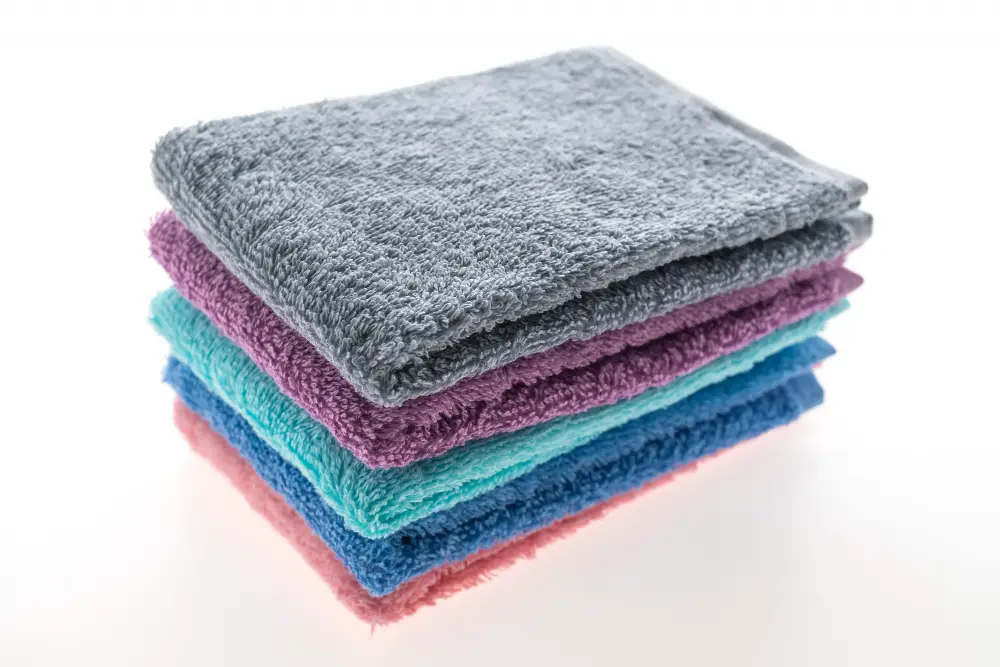
The key to keeping your white couch clean is dealing with spills immediately. The longer a spill sits on your couch, the harder it will be to remove and the more likely it is to leave a stain.
As soon as you notice a spill, grab some paper towels or a clean cloth and blot up as much of the liquid as possible. Avoid rubbing or scrubbing at this stage because that can push the stain deeper into the fabric.
Next, mix together some warm water and mild dish soap in a bowl. Dip another clean cloth into this solution and gently dab at any remaining residue until it’s gone.
If there’s still an obvious mark after cleaning up with soapy water then try using baking soda paste (mixing baking soda with water) for extra stubborn stains like red wine.
Proper Stain Removal Techniques
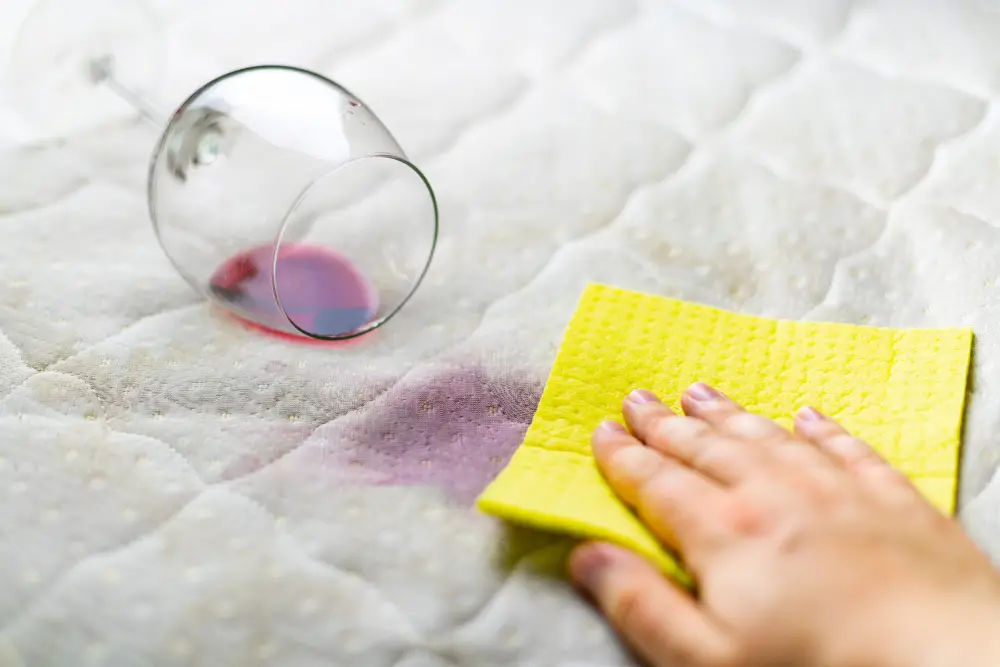
Accidents happen, and spills are inevitable, but with the right approach, you can minimize the damage and prevent stains from setting in.
The first step is to act quickly. The longer a stain sits on your couch fabric or cushions, the harder it will be to remove.
Use a clean cloth or paper towel to blot up as much of the spill as possible without rubbing it into the fabric.
Next, identify what type of stain you’re dealing with so that you can use an appropriate cleaning solution. For example:
- Water-based stains: Blot with cold water.
- Oil-based stains: Use dish soap mixed with warm water.
- Ink Stains: Apply rubbing alcohol using cotton balls
- Bloodstains: Mix hydrogen peroxide and dish soap
Always test any cleaning solution on an inconspicuous area before applying it directly onto your white couch’s visible surface.
Finally – avoid using hot water when removing any kind of stain from your white sofa since heat sets most types of spots permanently into fabrics instead use lukewarm or cool temperature for washing away dirt marks gently.
White Vinegar Magic
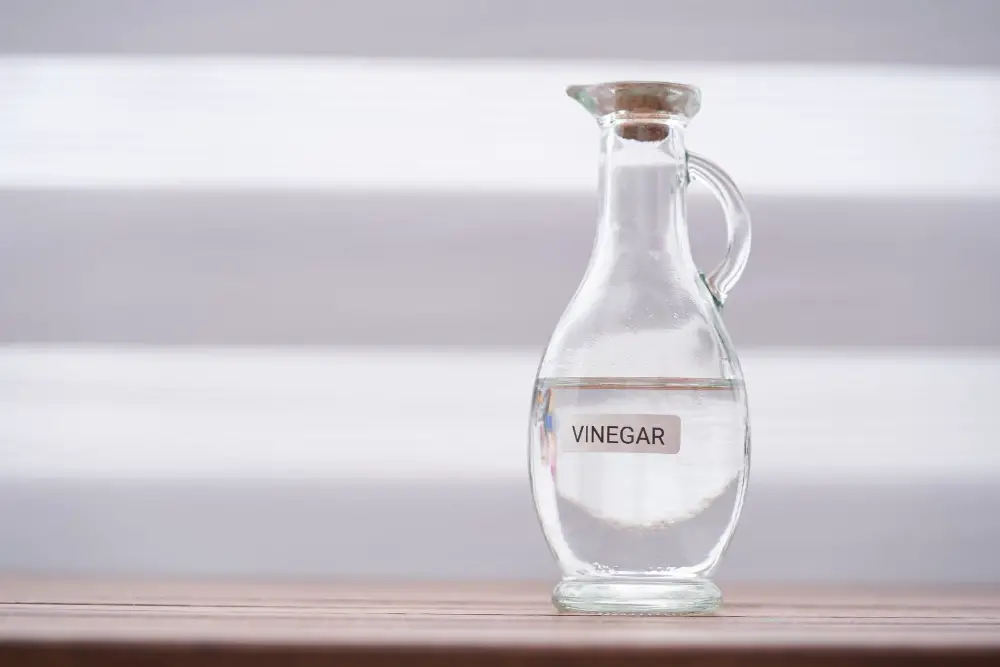
It’s an all-natural, non-toxic cleaning solution that’s safe to use on most fabrics. White vinegar works wonders in removing stains and odors from your couch without damaging the fabric or leaving any residue behind.
To use white vinegar for cleaning your white couch, mix equal parts of water and distilled white vinegar in a spray bottle. Spray the solution onto the stained area of your couch and let it sit for 10-15 minutes before blotting it with a clean cloth or paper towel.
For tough stains like red wine or coffee, you can apply undiluted white vinegar directly onto the stain using a soft-bristled brush. Let it sit for 5-10 minutes before wiping away with a damp cloth.
Remember to always test any new cleaning method on an inconspicuous area first to ensure there are no adverse effects on color or texture.
Baking Soda Solutions
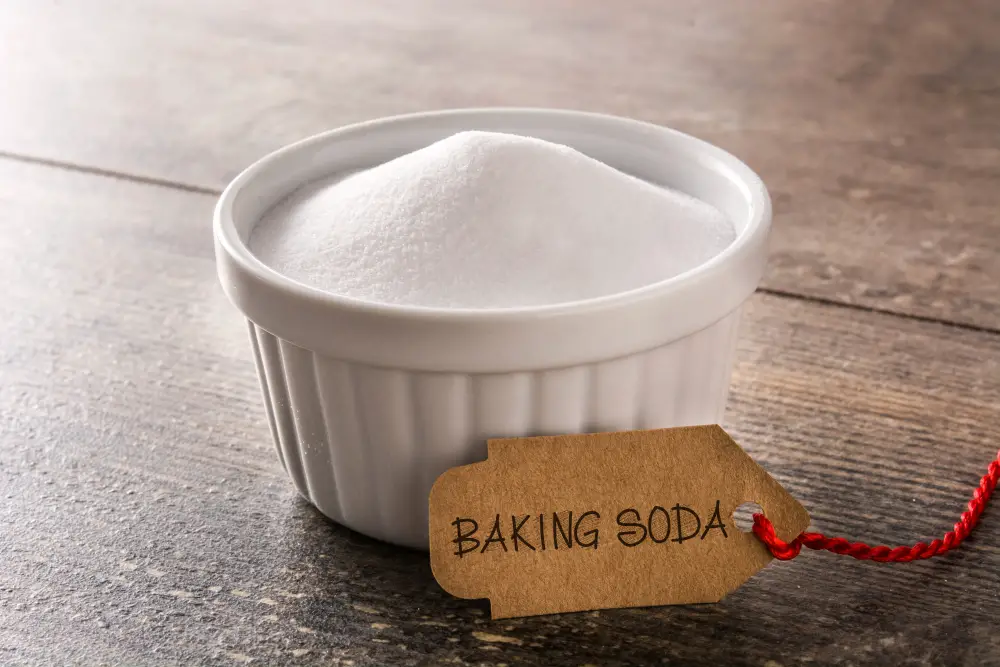
It’s an excellent natural deodorizer, stain remover, and general cleaner. To use baking soda to clean your white couch, sprinkle it generously over the surface of the fabric and let it sit for at least 15 minutes (or longer if possible).
Then use a soft-bristled brush or vacuum cleaner to remove the baking soda residue.
For tough stains like red wine or coffee spills, you can make a paste by mixing equal parts water and baking soda. Apply this paste directly onto the stain with a cloth or sponge and let it sit for about half an hour before wiping away with warm water.
It’s important to note that while baking soda is generally safe for most fabrics, you should always test any cleaning method on an inconspicuous area first before applying it more broadly.
Gentle Cleaning Products
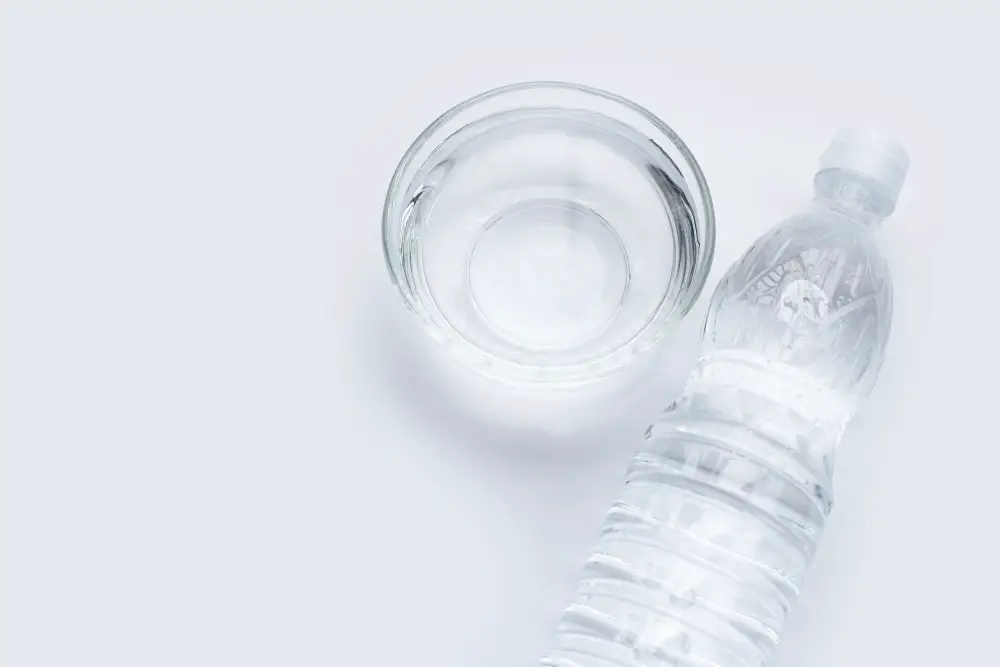
They can damage the fabric and leave behind unsightly stains or discoloration. Instead, opt for gentle cleaning products that are specifically designed for delicate fabrics like those found on a white couch.
Look for mild detergents or upholstery shampoos that contain no bleach or ammonia. These products will effectively remove dirt and grime without damaging the fabric’s fibers.
Another option is to use natural cleaning solutions such as vinegar mixed with water in equal parts, which is an excellent alternative to chemical-based cleaners. Simply spray the solution onto any stained areas of your couch and gently blot with a clean cloth until the stain disappears.
Remember always to test any new product on an inconspicuous area of your sofa before using it all over; this way you can ensure there won’t be any adverse reactions between cleaner and material.
Professional Cleaning Services
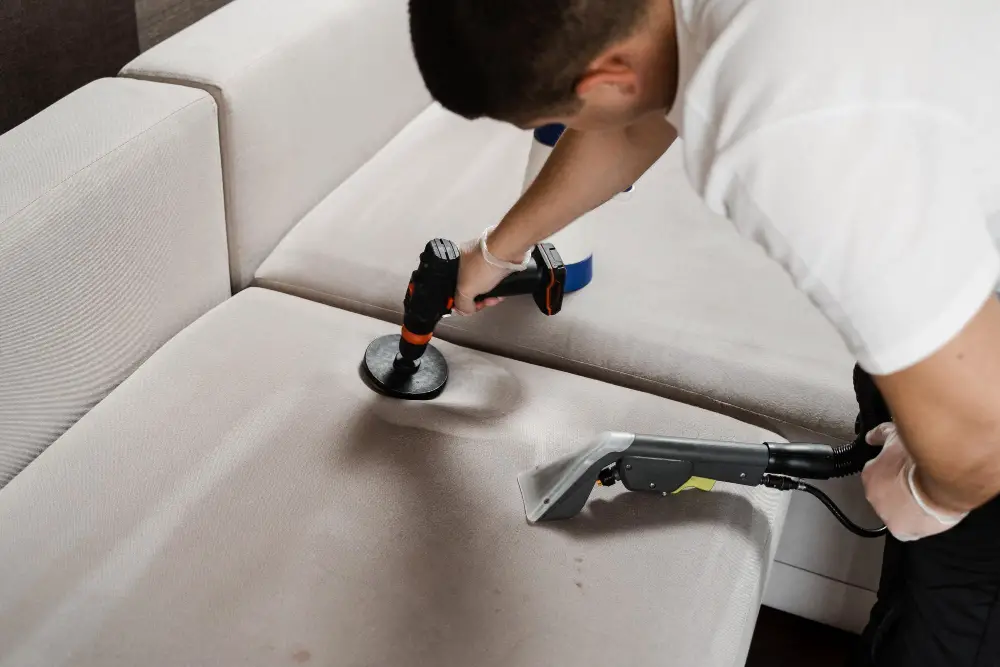
Professional cleaners have the expertise and equipment needed to tackle even the toughest stains and dirt buildup. They can also help extend the life of your couch by using specialized cleaning products that won’t damage its delicate fabric.
While professional cleaning services may be more expensive than DIY methods, they are often worth the investment in terms of time saved and results achieved. Plus, with regular maintenance from professionals every few years or so, you’ll be able to enjoy your beautiful white couch for many years without worrying about stubborn stains ruining its pristine look.
Remember that prevention is always better than cure when it comes to keeping a white couch clean.
Deep Clean Periodically
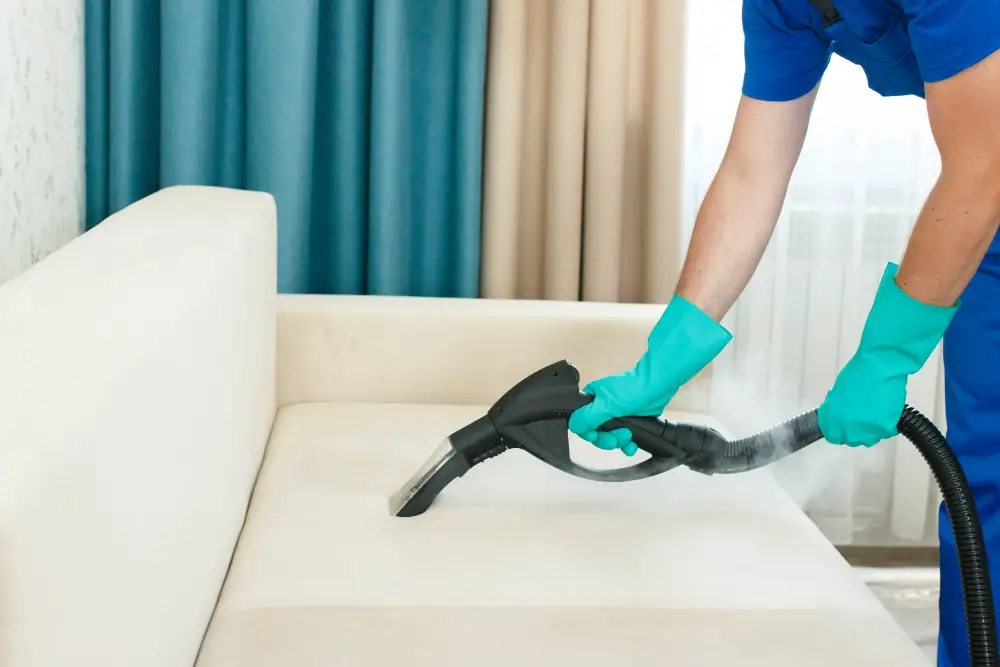
Deep cleaning involves a more thorough process that goes beyond just vacuuming and spot-cleaning.
To deep clean your white couch, start by removing all the cushions and vacuuming every nook and cranny of the sofa. Use a soft-bristled brush attachment to gently scrub away any dirt or debris that has accumulated over time.
Next, check for any stains or spots on the fabric. If you notice anything, use an appropriate stain remover according to manufacturer instructions (or test in an inconspicuous area first).
Be sure not to oversaturate the fabric with water as this can cause damage.
After treating any stains, give your couch a good overall cleaning using gentle upholstery cleaner products specifically designed for white fabrics. Follow manufacturer instructions carefully when applying these cleaners – some may require dilution before use while others should be applied directly onto the surface of your sofa.
Test Cleaning Methods On Hidden Areas
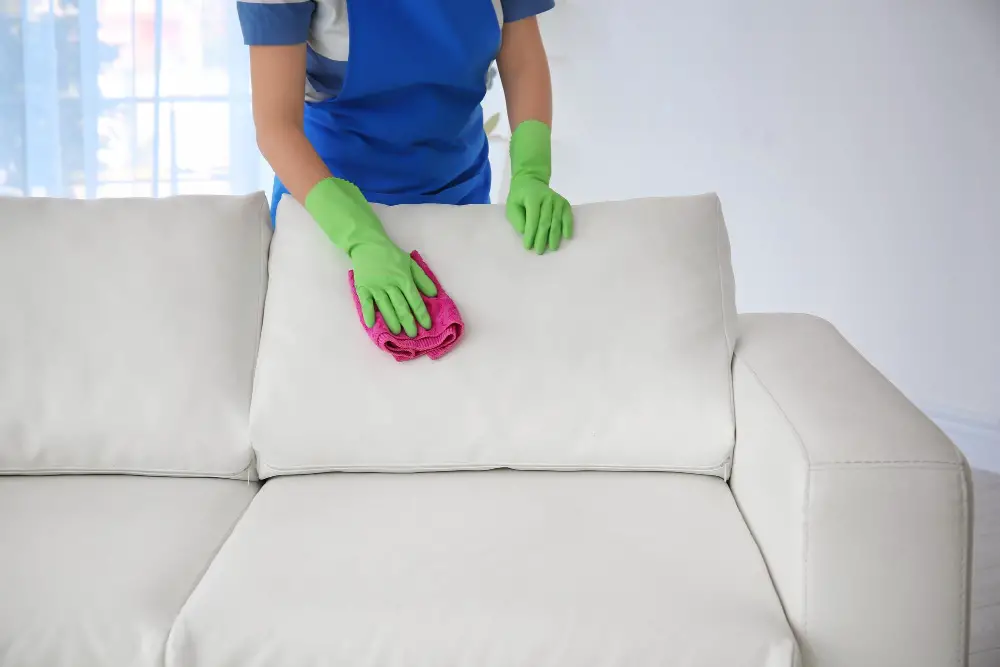
This will help you avoid any potential damage or discoloration to the fabric. Choose an inconspicuous spot, such as the back of a cushion or under the armrest, and apply a small amount of your chosen cleaner using a clean cloth.
Gently rub in circular motions and then blot with another clean cloth.
If there is no adverse reaction after 24 hours, proceed with confidence knowing that this method is safe for use on your couch. Testing beforehand can save you from costly mistakes and ensure that your white couch stays looking its best for years to come!
FAQ
Is white couch hard to keep clean?
Yes, a white couch can be more challenging to maintain its cleanliness compared to darker and patterned sofas, although there are ways to incorporate light-colored furniture without causing much hassle.
What is the best thing to clean a white couch?
The best thing to clean a white couch is a combination of white vinegar for natural whitening, dish soap for non-damaging stain removal, and a microfiber cloth for effective cleaning.
What preventative measures can be taken to maintain the cleanliness of a white couch?
To maintain the cleanliness of a white couch, use slipcovers, avoid eating or drinking on it, vacuum regularly, and promptly clean spills or stains.
How can stain-resistant fabric protectors be used to extend the cleanliness of a white couch?
Stain-resistant fabric protectors can extend the cleanliness of a white couch by creating a protective barrier that repels liquids and prevents dirt or spills from settling into the fibers.
How often should a white couch be professionally cleaned for optimal upkeep?
White couches should be professionally cleaned at least once a year for optimal upkeep.




